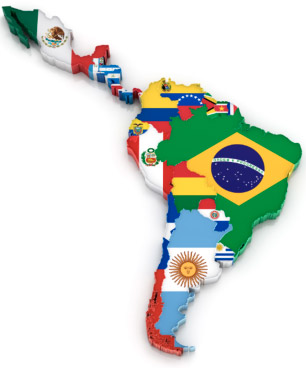By Luigi Major
The 2016 HOLA conference roused both enthusiasm and caution for Latin America’s hotel industry. Major markets benefit from their alignment with the U.S. dollar, but hurt from oversupply. Smaller markets, however, may be poised for growth.

On the brighter side, an increasing amount of travel among Latin America’s middle class and undersupplied secondary and tertiary markets in the region pose the opportunity for growth, particularly for branded hotels.
A downgrade in commodity prices, especially for crude oil, has been affecting Latin America ever since prices peaked in mid-year 2011. Owing to both supply and demand factors, oil prices began to decrease in late 2014, bottoming out early this year. Prices of other commodities such as iron ore, copper, and grains have also dropped.
Because the region’s economies rely so heavily on commodity production, these declines bring significant challenges. Declining demand from other nations, along with the ongoing recession in Latin American countries, has slowed exports, particularly to China, the region’s largest importer.
There is some positive news, however, for specific markets. The recent drop in oil prices affects oil exporters like Colombia but helps importers like Chile. The reduction in the price of oil will lower the value of oil reserves in Argentina, Brazil, and Mexico, at least in the near term; however, oil prices have been on a slow but steady upswing since early 2016, resulting in the expectation that a recovery has taken root.
Currencies in the most prominent Latin American economies have depreciated as a result of falling commodity prices, a stronger U.S. dollar, and an outlook of sluggish growth in China. Currency depreciation in just the last three years, on average, is a staggering 30%. While the region’s emerging markets have typically held the promise of higher yields, Latin America has been at the forefront of a selloff among emerging markets worldwide, the result of stronger economic conditions in the U.S.

With respect to hotels, assets whose primary rate position is set in the U.S. dollar (namely hotels located in capital cities and resort markets) remain unaffected by regional currency fluctuations and instead benefit from higher revenues when converted to the local currency. However, assets that are more dependent on local currencies have been hit with plummeting average rates.
The currency depreciation has also weakened consumer spending, causing a decrease in Latin American travelers visiting other countries in the region, while perhaps increasing domestic travel. Moreover, the favorable exchange rates make these Latin American destinations less expensive for North American travelers, resulting in a potential increase in travel from the U.S.
Major Latin American cities have experienced an influx of new hotel supply in recent years. In fact, markets such as Panama City, Panama, had been oversaturated with year-over-year supply increases for years, a trend that has only recently let up. The pace of new development in the region reflects, in some part, a lack of proper due diligence, with well-capitalized family companies and multi-sector developers embarking on projects on a whim.
The onset of economic uncertainty has slowed the increase in supply, however, and Latin American hotel markets remain for the most part undersupplied. By comparison, rooms supply in the United States is nine times greater per capita compared with that of Latin America, presenting some markets with opportunities for growth.
Mexico and Chile, in particular, continue to emerge as the region’s most diverse and upward-bound economies. This is reflected in these nations’ healthy manufacturing sectors and the success of their hospitality markets, which boast stable occupancies and strong tourism.
Meanwhile, supply growth in Brazil is expected to be below the average for the region, due to significant increases in supply, coupled with economic declines, over the last few years, and an overall weak economic outlook. Similarly, supply growth in Colombia is set to slow, as government incentives designed to prompt hotel development also created a bloat in supply over the last few years.
Peru’s supply growth has remained relatively muted in the recent past, and sound economic performance, favorable business policies, and the country’s emergence as a cultural and culinary destination support a positive outlook for its hotel industry. In fact, Peru is expected to realize dominant growth in supply over the next few years, especially in secondary and tertiary markets. Argentina, another of Latin America’s top economic powers, has likewise received only marginal increases in hotel supply in recent years, despite major infrastructural projects in the nation.
The growing acquisition power of the Latin American middle class is becoming more and more evident, prompting increases in both commercial and leisure travel. As mentioned previously, this has created opportunities for growth in secondary hotel markets, specifically for branded hotels.
Latin America as a whole remains underserved by brand-affiliated hotels. The majority of Latin American hotels are operated independently—only 46% of the region’s hotels are branded. Delegates at the HOLA conference shared a general expectation that branded supply will increase in the region through the conversion of independent hotels to branded hotels, as well as the growing trend of family companies affiliating their properties with brands.
By 2025, Latin America’s mix of branded versus independent hotels is expected to shift to approximately 55% to 41%, respectively. Notably, the expansion of hotel brands could also catalyze an increase in demand and new opportunities for high-quality professional hotel management companies in the region.
The Latin American hotel industry is vast in scope, and opportunities, particularly in the region’s best-performing economies and certain smaller markets, exist for well-advised hoteliers. HOLA speakers and delegates, however, urged caution moving forward, given concern that the U.S. is near the end of its economic recovery and the global market for Latin American commodities is continuing to soften.
Under the pressure of these economic conditions, the pace of performance growth for Latin America’s hotel industry has slowed significantly since 2012/13. On the upside, supply growth has also settled over the past year, establishing some long overdue opportunities for expansion in specific markets. Additionally, a growing, traveling middle class continues to present the opportunity for supply increases in Latin America, particularly branded hotels in secondary and tertiary cities. Proper due diligence in hotel operations, branding, and development in the region will further offset risks; thus, the outlook would be best defined as cautiously optimistic.








